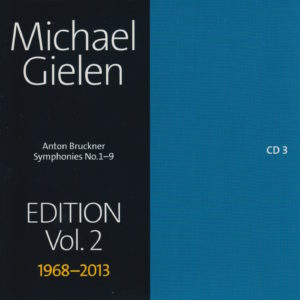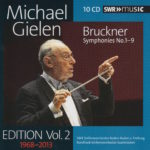 This morning’s conductor of Anton Bruckner’s Symphony No. 3 in D Minor (WAB 103), nicknamed “Wagner,” is German-born Michael Gielen (1927-). The orchestra is SWR Sinfonieorchester Baden-Baden und Frieburg.
This morning’s conductor of Anton Bruckner’s Symphony No. 3 in D Minor (WAB 103), nicknamed “Wagner,” is German-born Michael Gielen (1927-). The orchestra is SWR Sinfonieorchester Baden-Baden und Frieburg.
I encountered Mr. Gielen twice before: On Day 4 and on Day 20.
On Day 4, I wrote this:
This is an odd one for me.
The recording was superb.
The performance was also superb.
Yet, this didn’t move me. It seemed so, for want of a better word, big.
On Day 20, I wrote this:
This almost made me do cartwheels this morning.
So far, this Gielen interpretation of one of Bruckner’s symphonies is my favorite! Out of all symphonies and all conductors and orchestras!
 Obviously, either Mr. Gielen’s performances are uneven, or my listening is. But that widely divergent rating (two thumbs up for Day 20, two thumbs down for Day 4) is something to consider as I listen this morning to Mr. Gielen’s interpretation of Bruckner’s Third Symphony.
Obviously, either Mr. Gielen’s performances are uneven, or my listening is. But that widely divergent rating (two thumbs up for Day 20, two thumbs down for Day 4) is something to consider as I listen this morning to Mr. Gielen’s interpretation of Bruckner’s Third Symphony.
It’s time to dive into the nuts and bolts of this morning’s recording:
Bruckner’s Symphony No. 3 in D Minor, composed in 1873
The version used is the 1877, 2nd version
Michael Gielen conducts
SWR Sinfonieorchester Baden-Baden und Frieburg plays
The symphony clocks in at 55:40
This was recorded in May, 1999, in (I think) Baden-Baden, Germany
Gielen was ?? when he conducted it
Bruckner was 49 when he composed it
This recording was released on the SWR Music Label
Bruckner wrote his symphonies in four parts. The time breakdown of this one (Symphony No. 3 in D Minor, 1877, 2nd version), from this particular conductor (Chailly) and this particular orchestra (Deutsches Symphonie-Orchester Berlin) is as follows:
Moderato (Mehr langsam, misterioso, officially)………………………….18:37
Andante (Bewegt, feierlich, quasi Adagio, officially)……………………..15:50
Scherzo…………………………………………………………………………………………..10:40
Finale………………………………………………………………………………………………15:56
Total: 55:40
Gielen’s Andante (Second Movement) is longer than that of the previous conductor’s version (Day 35, Tennstedt). And his Scherzo (Third Movement) is longer by nearly 10 minutes over Mr. Tennstedt’s. Normally, that probably wouldn’t bother me. But…
Now for the more subjective stuff.
My Rating:
Recording quality: 3
Overall musicianship: 4
CD liner notes: 4 (short essays on Gielen, the orchestra, and Bruckner, translated into English and German)
How does this make me feel: 2
The pendulum has swung back to two thumbs down.
The word “meh” or even “ho-hum” spring to mind with this recording.
FULL DISCLOSURE: I listened to this recording out of order. I was suppose to hear it yesterday, November 7th. But I was busy and didn’t get around to it. So I listened to today’s conductor (Haitink) first and then listened to yesterday’s (Gielen).
That means I listened to Haitink’s interpretation immediately before this one.
There’s no comparison between the two.
Haitink’s electrified me.
Gielen’s bores me to tears, at best, and – at worst – makes me long for it to be over. For example, the last 3-4 minutes of the Finale (Movement Four) instead of making me feel triumphant and eager to jump to my feet, irritated me like nails on a chalkboard. I couldn’t wait for it to end.
It’s something about the way the instruments are recorded, I think. The brass is way too brassy.
The tempo, overall, of this recording seems lugubrious. I know it’s likely not. But I think it feels that way because it lacks the kind of spark I need to give it life.
So far, Mr. Gielen is batting only 33% with me, which – I’m sure – keeps him awake at night.
I just can’t get too enthused about this recording – especially coming on the heels of Haitink’s. The difference is night and day. Not even the pizzicato starting aroiund the 8:30 mark of Movement One could cheer me up.
And if pizzicato can’t cheer me up, there’s something wrong.
